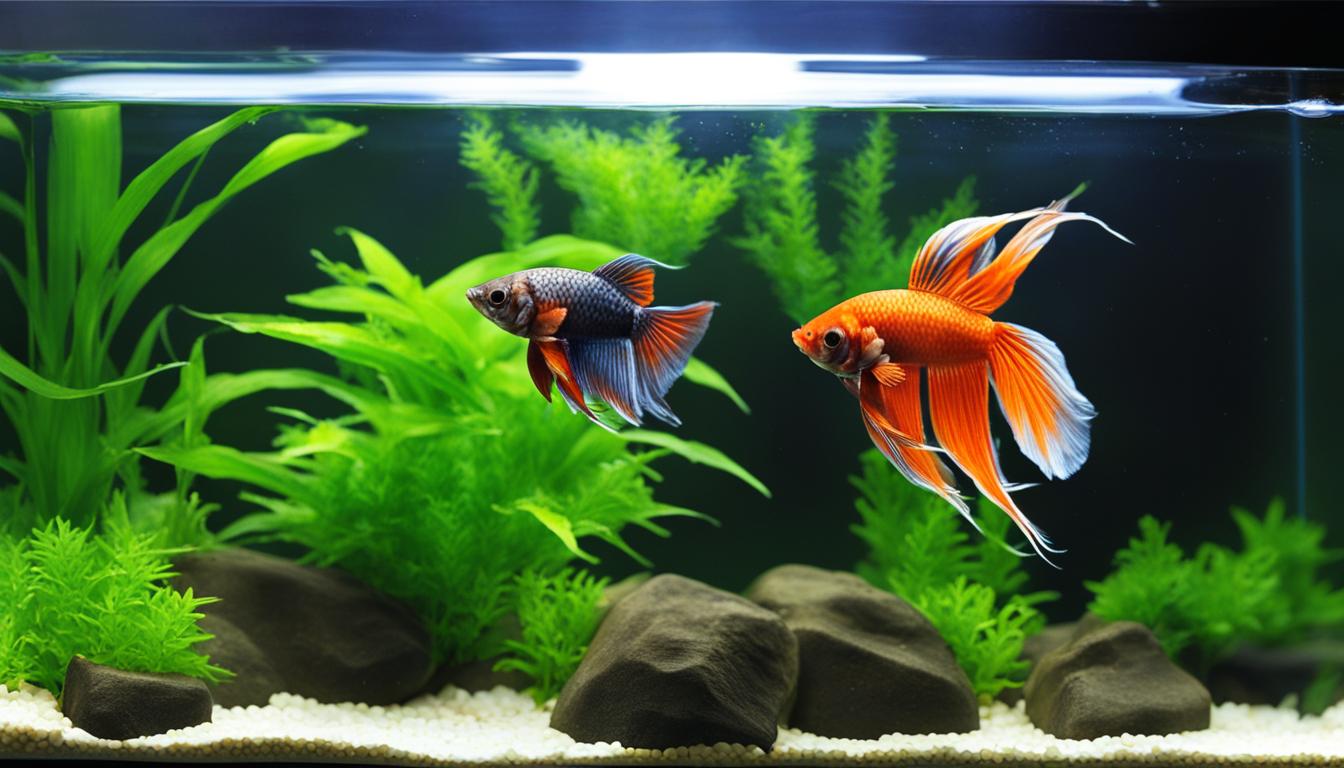Last Updated on 2 years by admin
Are you considering adding a fish to your home aquarium? Betta fish and goldfish are both popular choices for beginners, but which one is easier to care for? In this article, we will explore the key differences between betta fish and goldfish, including their care requirements, temperament, tank size, water flow, and temperature needs. By the end, you’ll have a better understanding of which fish is the right fit for your lifestyle.
Key Takeaways:
- Betta fish require smaller tanks and prefer warmer water temperatures, while goldfish need larger tanks with cooler water.
- Betta fish are more territorial and may not be compatible with other fish, while goldfish are social and can live with other goldfish.
- Both betta fish and goldfish require proper filtration and regular tank maintenance for optimal health and well-being.
- Consider your own preferences, tank size, and ability to provide the necessary care before choosing between betta fish and goldfish.
- Consult with an aquarium expert or pet store specialist for personalized advice based on your specific situation.
Myth #1: Bettas come from mud muddles and rice patties, so they don’t need a lot of water.
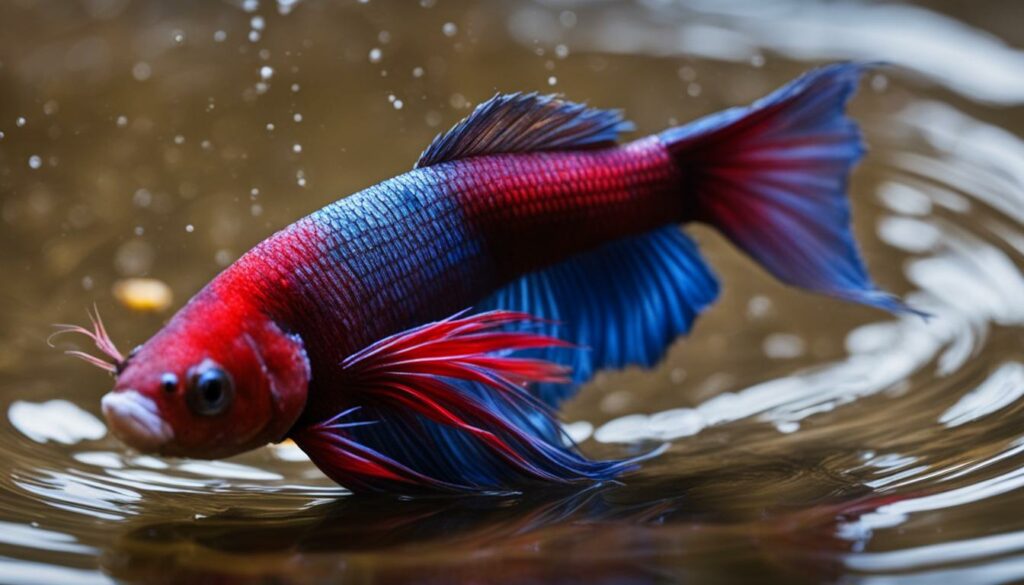
One common myth about betta fish is that they come from muddy environments, so they don’t need a lot of water. However, betta fish are naturally found in shallow streams and ponds with little water flow but spanning over a large horizontal area. In reality, betta fish need adequate space to swim and thrive. Keeping betta fish in small bowls or tanks can lead to stress, ammonia buildup, and temperature fluctuations that can harm their health.
Betta fish care tips:
- Provide a tank with a minimum capacity of 5 gallons to allow ample swimming space.
- Ensure the tank is properly filtered to maintain water quality.
- Use a heater to keep the water temperature between 78-80°F (25-27°C).
- Add live or silk plants and decorations to create hiding spots and simulate their natural habitat.
“Betta fish require more space than commonly believed. Providing them with a larger tank and appropriate conditions is essential for their well-being.” – Betta Fish Care Expert
By debunking the myth that bettas don’t need a lot of water, fishkeepers can better understand the importance of providing their betta fish with a suitable environment that mimics their natural habitat. A well-maintained tank with adequate space and optimal conditions is key to ensuring the health and happiness of these beautiful fish.
| Betta Fish | Goldfish | |
|---|---|---|
| Minimum Tank Size | 5 gallons | 20 gallons for single-tail; 30 gallons for fancy-tail |
| Ideal Water Temperature | 78-80°F (25-27°C) | 65-75°F (18-24°C) |
| Water Flow | Gentle to low | Medium to high |
| Aquarium Setup | Plants, decorations, and hiding spots | Plants, decorations, and ample swimming space |
Table: Comparing Tank Size and Care Requirements of Betta Fish and Goldfish
Myth #2: Bettas like dirty water and cleaning it can stress them out.

Another myth about betta fish is that they like dirty water, so frequent cleaning can stress them out. In reality, betta fish are sensitive to ammonia levels in the water and need their tanks to be clean and well-maintained. Dirty water can lead to ammonia poisoning, which can make betta fish sick and eventually lead to their death. Regular water changes and proper filtration are essential for the health of betta fish.
Betta fish are known for their vibrant colors and beautiful fins, but these features can be an indicator of their overall health. Keeping their tanks clean not only promotes good physical health, but it also ensures a stress-free environment for these fascinating creatures. Ammonia buildup in the tank can cause betta fish to become lethargic, lose their appetite, and experience fin rot. By maintaining a clean tank, betta owners can prevent these issues and provide a safe and comfortable habitat for their fish.
To keep a betta tank clean, it is recommended to perform regular water changes. Betta fish tanks should have their water changed at least once a week, but more frequent changes may be necessary depending on the tank size and filtration system. Using a siphon or gravel vacuum can help remove debris and waste from the bottom of the tank, while a water conditioner should be used to neutralize any harmful substances in tap water. By following these care tips, betta keepers can ensure their fish live long and healthy lives.
Table: Cleaning Frequency for Betta Fish Tanks
| Tank Size | Water Change Frequency |
|---|---|
| 1-5 gallons | Once a week |
| 5-10 gallons | Every 7-10 days |
| 10-20 gallons | Every 10-14 days |
Betta Fish Care Tips: Busting Myth #3 – Large Spaces and Betta Fish

One of the common misconceptions about betta fish is that they do not like large spaces and feel safer in smaller enclosures. However, this couldn’t be further from the truth. Betta fish actually thrive in larger tanks with ample swimming space. Providing a suitable-sized tank is essential for their overall well-being.
When betta fish are kept in small spaces, such as bowls or tiny tanks, they can become stressed and may exhibit signs of poor health. They need room to explore and establish territories. In larger tanks, betta fish are more likely to engage in their natural behaviors and feel less confined.
To ensure the comfort of your betta fish, it’s important to provide a tank that is at least 5 gallons in size. This will give them the freedom to swim and exercise, promoting better physical and mental health. Additionally, make sure the tank has plenty of hiding spots and decorations to create a stimulating environment.
Remember, the myth that betta fish prefer small spaces is just that – a myth. By giving your betta fish a larger tank and a suitable environment, you are providing them with the space they need to thrive and lead a healthy, happy life.
Myth #4: Keeping a Betta in a Vase with Plant Roots Simulates Their Wild Environment
One common myth about betta fish care is that keeping them in a vase with plant roots simulates their natural environment. However, this is not true. Betta fish are insectivores and require a diet rich in protein, not plant roots. While it is true that betta fish are often found in shallow streams and ponds in the wild, their natural habitat consists of a larger horizontal area with plenty of space to swim.
A vase with plant roots does not provide the necessary nutrients and variety in their diet, leading to potential malnutrition. Additionally, plant roots do not naturally filter the water to a significant degree. The lack of proper filtration can result in ammonia buildup, which is harmful to betta fish health. The water temperature in a vase may also fluctuate, exposing the betta fish to cold temperatures that can weaken their immune system and make them more susceptible to illness.
The best way to care for a betta fish is to provide them with a properly filtered and heated aquarium. This will ensure a stable and controlled environment that meets their specific needs. A suitable betta fish tank should have a capacity of at least 5 gallons with appropriate filtration, a heater to maintain a consistent temperature between 78-80°F (25-27°C), and regular water changes to maintain water quality.
“While it may seem aesthetically pleasing to keep a betta fish in a vase with plant roots, it is important to prioritize their health and well-being by providing the proper care and environment.”
| Myth | Reality |
|---|---|
| Keeping a Betta in a vase with plant roots simulates their wild environment | A properly filtered and heated aquarium is necessary for their well-being |
| Betta fish are insectivores and require a diet rich in protein, not plant roots | Proper nutrition is essential for their health and vitality |
| Plant roots do not naturally filter the water to a significant degree | Proper filtration is necessary to maintain water quality |
By debunking this myth and providing the correct information about betta fish care, we can ensure that these beautiful fish thrive in a suitable and healthy environment. It is important to prioritize their well-being and provide them with the care they need to live a happy and fulfilling life.
Betta Fish vs Goldfish Compatibility: Debunking Common Myths
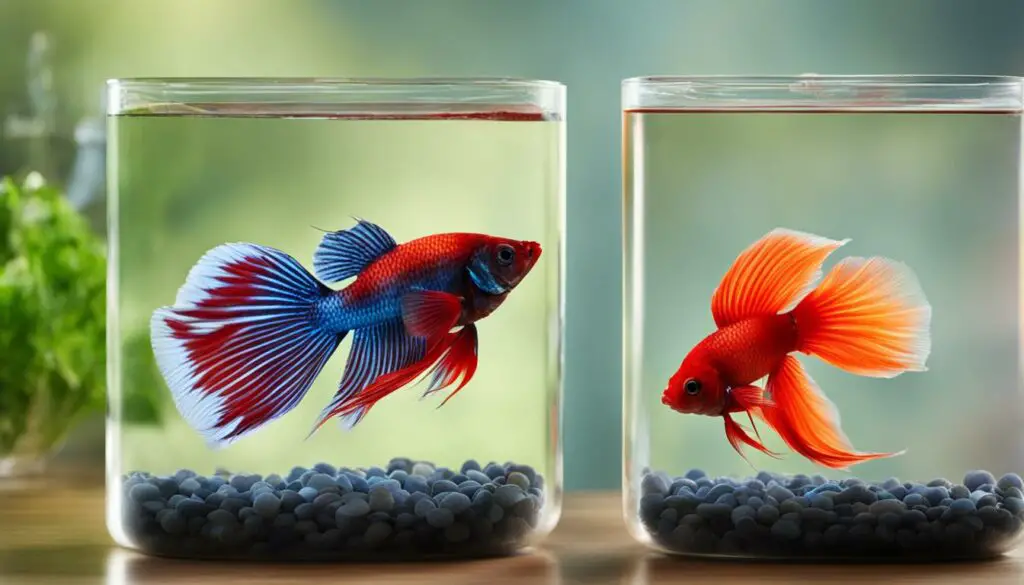
There is a common misconception that female betta fish are peaceful and can be kept together without any issues. While female bettas may be less aggressive compared to their male counterparts, they can still display territorial behavior and aggression towards each other, especially when establishing a hierarchy. Therefore, it is important to exercise caution when keeping multiple female bettas in the same tank.
To ensure the well-being of female bettas in a community tank, it is crucial to provide a spacious environment with plenty of hiding spots and resting areas. A tank size of at least 20-30 gallons is recommended, as this allows each fish to establish its own territory and reduces the likelihood of aggressive behavior. Monitoring their behavior closely is essential, and if any signs of aggression are observed, it may be necessary to separate the fish into individual tanks.
Furthermore, it is important to note that betta fish and goldfish have different care requirements and are not compatible tank mates. Goldfish produce more waste and require larger tanks with stronger filtration, while betta fish need smaller tanks with slower water flow. Mixing these two species together can lead to stress, aggression, and unsuitable living conditions for both fish.
When considering betta fish versus goldfish compatibility, it is crucial to prioritize the welfare of the fish and provide them with appropriate living conditions. By understanding and respecting the specific needs of each species, fishkeepers can ensure a harmonious and healthy environment for their aquatic companions.
Myth #6: Bettas don’t move around very much so they don’t need a large tank.

One common myth about betta fish is that they don’t move around much and therefore don’t require a large tank. While it is true that some betta fish may be less active than others, all betta fish need a certain amount of space to swim and thrive. Betta fish are naturally curious and enjoy exploring their environment. Providing a large enough tank allows them to exhibit their natural behaviors and promotes their overall well-being.
When confined to small tanks, betta fish can become stressed and may exhibit signs of poor health. Limited swimming space can lead to muscle degeneration and contribute to weight gain. A lack of stimulation and exercise can also result in boredom and lethargy. Inadequate tank size can compromise water quality and make it more difficult to maintain the necessary temperature and filtration requirements for betta fish.
To ensure the well-being of your betta fish, it is recommended to provide a tank that is at least 5 gallons in size. This will give your fish ample space to swim and explore, as well as room for decorations, plants, and hiding spots. A larger tank also allows for better water circulation and filtration, which helps maintain a clean and stable environment for your betta fish.
Table: Tank Size Recommendations for Betta Fish
| Tank Size (in gallons) | Recommended for |
|---|---|
| 2.5-5 | One betta fish |
| 10+ | Multiple betta fish |
Betta Fish Myth #7: Bettas make a bubble nest when they are happy
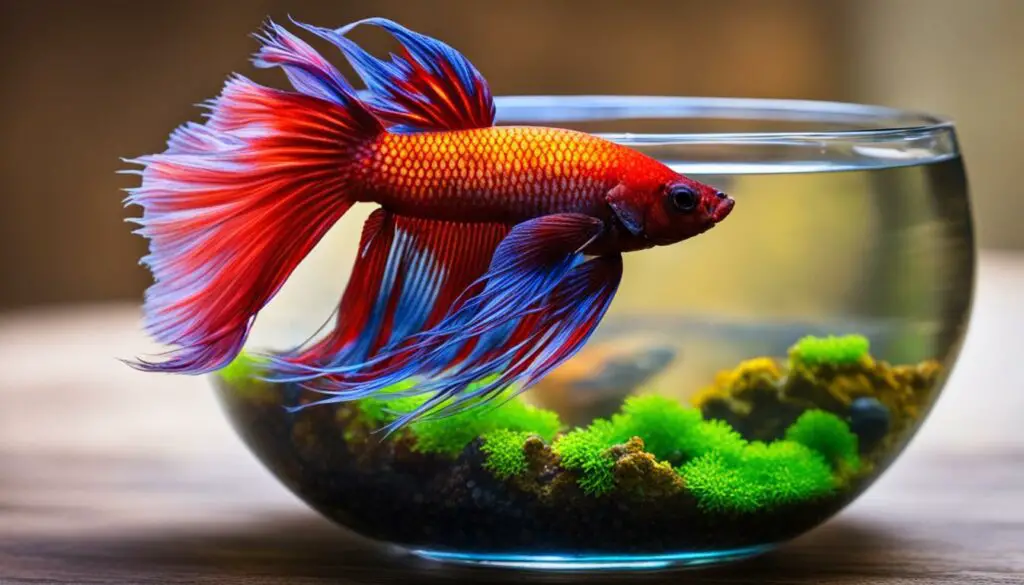
One common misconception about betta fish is that they build bubble nests only when they are happy. Bubble nesting is actually an instinctual behavior for male betta fish, and it serves a specific purpose in their natural habitat. Male bettas build bubble nests to attract female mates and protect their eggs. The presence of a bubble nest does not necessarily indicate a betta fish’s overall happiness or well-being. It is more important to focus on providing proper care and a suitable environment for betta fish to thrive.
Bubble nesting behavior can vary among individual betta fish. Some may build bubble nests more frequently or in larger sizes, while others may not build nests at all. Factors such as water temperature, water quality, and the presence of female betta fish can influence a male betta’s inclination to build a bubble nest. Even betta fish that are sick or stressed may still exhibit bubble nesting behavior.
While bubble nests can be fascinating to observe and can provide insights into a betta fish’s reproductive behavior, they should not be the sole measure of a betta fish’s happiness or health. It is essential to focus on maintaining a well-maintained tank with appropriate water conditions, proper nutrition, and regular check-ups to ensure the overall well-being of betta fish.
| Key Points |
|---|
| Bubble nests are an instinctual behavior for male betta fish and do not indicate overall happiness. |
| Factors such as water temperature and the presence of female bettas can influence bubble nesting behavior. |
| Focus on providing proper care and maintaining a well-maintained tank for betta fish’s overall well-being. |
Myth #8: Female bettas do not flare, do not bubble nest, and are duller than male bettas
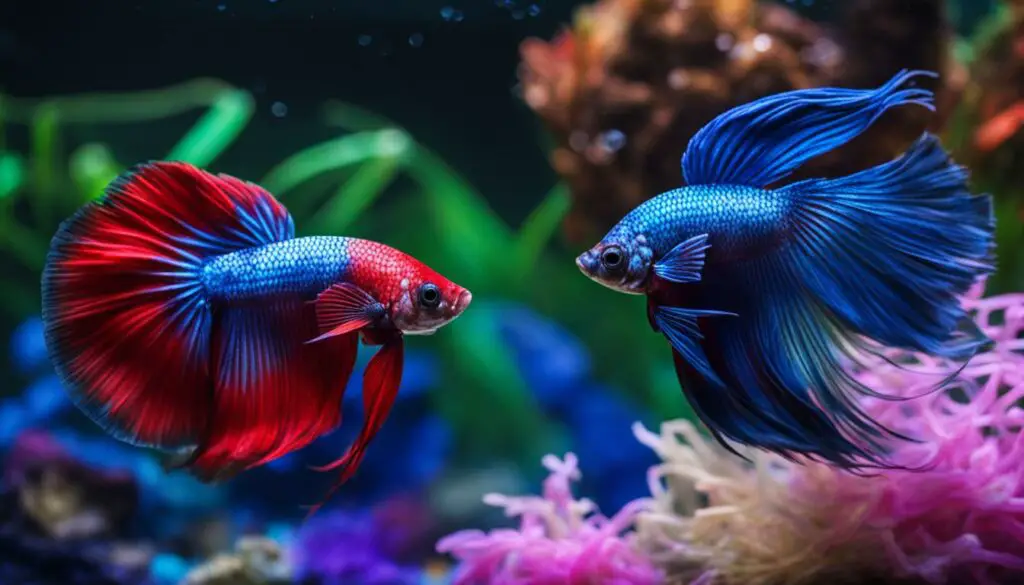
It is a common misconception that female bettas do not flare, do not make bubble nests, and are less vibrant compared to male bettas. In reality, female bettas can indeed flare their fins, make bubble nests, and come in a variety of colors and patterns, similar to male bettas. Both male and female bettas possess these behaviors and characteristics, and they should be appreciated for their individual uniqueness.
Contrary to popular belief, female bettas can display the impressive fin flaring behavior that is often associated with males. Flaring is a natural behavior that bettas use to communicate and establish dominance. While males may flare more frequently and aggressively, females can also exhibit this behavior, especially during territorial disputes or when threatened. By flaring their fins, female bettas assert their presence and defend their territory, showcasing their beauty and strength.
In addition to fin flaring, female bettas are also capable of creating bubble nests. Bubble nesting is an instinctual behavior in bettas, regardless of their gender. Male bettas build bubble nests to attract female mates and protect their eggs. However, female bettas have been observed making bubble nests in the absence of males, suggesting that this behavior serves other functions as well. Bubble nests can provide a sense of security and comfort for bettas, and female bettas are no exception.
Finally, it is important to highlight that female bettas are just as vibrant and colorful as their male counterparts. While male bettas are renowned for their bright hues and elaborate finnage, females can also exhibit stunning colors, patterns, and personalities. From shimmering blues and vibrant reds to elegant marbles and unique combinations, female bettas possess their own unique beauty. Appreciating and celebrating the diversity of betta fish, regardless of their gender, enriches our understanding and enjoyment of these captivating aquatic creatures.
| Myths | Reality |
|---|---|
| Female bettas do not flare their fins | Female bettas can flare their fins, although may be less frequent or less aggressive compared to males. |
| Female bettas do not make bubble nests | Female bettas can make bubble nests, providing a sense of security and comfort. |
| Female bettas are duller than male bettas | Female bettas can exhibit vibrant colors and unique patterns, just like male bettas. |
Myth #9: Bettas can be kept with goldfish since both live happily in bowls
One of the common misconceptions about betta fish and goldfish is that they can be kept together in the same tank, even in bowls. However, this is a myth that can lead to serious consequences for both fish. Betta fish and goldfish have different care requirements and are incompatible tank mates. It’s important to understand the distinct characteristics of each species before considering keeping them together.
Betta fish, also known as Siamese fighting fish, are tropical fish that thrive in warm water temperatures ranging from 78 to 80 degrees Fahrenheit. On the other hand, goldfish are coldwater fish that prefer cooler temperatures between 65 and 75 degrees Fahrenheit. Mixing betta fish and goldfish in the same tank would require compromising on the ideal temperature range for either species, which can lead to stress, weakened immune systems, and potential diseases.
Furthermore, goldfish produce a significant amount of waste, which requires a larger tank with sufficient filtration capacity to maintain water quality. On the contrary, betta fish prefer smaller tanks with slower water flow to prevent their long, delicate fins from getting damaged. Keeping goldfish in a small bowl or tank without proper filtration can result in overcrowding and poor water quality, which is detrimental to both the goldfish and the betta fish.
| Betta Fish | Goldfish |
|---|---|
| Require warm water temperatures (78-80°F) | Prefer cooler water temperatures (65-75°F) |
| Smaller tanks with slow water flow | Larger tanks with stronger filtration |
| Delicate fins | Rugged and sturdy body |
| Insectivorous diet | Herbivorous diet |
| Can be territorial and aggressive | Generally peaceful but can grow large |
Note: These are general characteristics and care requirements for betta fish and goldfish. Individual fish may have specific needs and behaviors that should be considered.
Tank Size and Care Requirements for Betta Fish and Goldfish
When it comes to tank size and care requirements, betta fish and goldfish have distinct needs. Betta fish, also known as Siamese fighting fish, thrive in tanks that are a minimum of 10 gallons. This size provides ample space for swimming and establishing territories, which is important for their well-being. A larger tank also allows for more stable water conditions and reduces the risk of ammonia buildup.
Proper filtration is crucial for both betta fish and goldfish. Betta fish prefer slow water flow, so a filter with adjustable settings is recommended. On the other hand, goldfish produce more waste and require a stronger filtration system to maintain water quality. Additionally, goldfish prefer cooler water temperatures, typically between 65-75°F (18-24°C), while betta fish thrive in warmer water, around 78-80°F (25-27°C). It’s important to consider these temperature requirements when choosing tank mates for each species.
“A suitable tank size is essential for the well-being of betta fish and goldfish. Providing enough space and proper environmental conditions ensures their physical and mental health.”
Betta fish also benefit from a well-decorated tank. Providing hiding spots, plants, and decorations not only adds visual appeal to the tank but also creates a stimulating environment for the fish. It’s important to choose decorations that are fish-safe and don’t have sharp edges that could potentially harm the delicate fins of betta fish.
| Betta Fish | Goldfish | |
|---|---|---|
| Minimum Tank Size | 10 gallons | 20 gallons for 1 goldfish, additional 10 gallons per goldfish |
| Water Temperature | 78-80°F (25-27°C) | 65-75°F (18-24°C) |
| Water Flow | Low to moderate | Strong |
| Filtration | Adjustable filter | Strong filtration system |
Table: Tank Size and Care Requirements for Betta Fish and Goldfish.
Conclusion
In conclusion, betta fish and goldfish are both popular choices for beginner fishkeepers, but they have distinct care requirements and compatibility factors to consider. When it comes to ease of care, it ultimately depends on your ability to meet their specific needs.
Betta fish are generally easier to care for in terms of tank size, water temperature, and water flow. They thrive in smaller tanks, warmer water temperatures, and prefer slower water flow. They also require hiding spots, plants, and decorations to create a stimulating environment.
On the other hand, goldfish need larger tanks, cooler water temperatures, and stronger filtration due to their larger size and higher waste production. They thrive in spacious environments and require ample filtration to maintain water quality.
Ultimately, the decision of which fish is easier to care for depends on your preferences, available resources, and level of commitment. Both betta fish and goldfish can be beginner-friendly fish for aquariums, but it is crucial to educate yourself on their specific needs and provide appropriate care to ensure their well-being.
FAQ
Are betta fish easier to care for than goldfish?
Betta fish and goldfish have different care requirements, but neither is necessarily easier to care for than the other. It depends on factors such as tank size, water temperature, and the ability to provide proper care for each species.
Do betta fish come from muddy environments, so they don’t need a lot of water?
No, this is a myth. Betta fish are naturally found in shallow streams and ponds with little water flow but spanning over a large horizontal area. They require adequate space to swim and thrive.
Do betta fish like dirty water, so frequent cleaning can stress them out?
No, betta fish are sensitive to ammonia levels in the water and need their tanks to be clean and well-maintained. Dirty water can lead to ammonia poisoning, which can make betta fish sick and eventually lead to their death.
Do betta fish do well in smaller enclosures and feel safer in smaller spaces?
No, betta fish actually do well in larger tanks with ample swimming space. They need room to explore and establish territories. Keeping them in small spaces can cause stress and poor health.
Does keeping a betta fish in a vase with plant roots provide a natural environment similar to their wild habitat?
No, betta fish are insectivores and require a diet rich in protein, not plant roots. Additionally, plant roots do not naturally filter the water to a significant degree. A properly filtered and heated tank is necessary for their well-being.
Are female bettas peaceful and can they be kept together?
Female bettas may be less aggressive compared to males, but they can still show aggression towards each other, especially when establishing a hierarchy. Keeping multiple female bettas in a tank requires careful planning, a large enough tank, and ample hiding spaces.
Do betta fish not move around much and therefore don’t require a large tank?
While some betta fish may be less active than others, all betta fish need a certain amount of space to swim and thrive. Providing a large enough tank allows them to exhibit their natural behaviors and promotes their overall well-being.
Is a bubble nest an indicator of a betta fish’s happiness?
No, bubble nesting is an instinctual behavior for male betta fish and is not necessarily an indicator of their happiness. It is important to focus on providing appropriate care and a suitable environment for betta fish rather than relying solely on bubble nesting as a measure of their well-being.
Do female bettas not flare, make bubble nests, and are they less vibrant compared to males?
No, female bettas can indeed flare their fins, make bubble nests, and come in a variety of colors and patterns, similar to male bettas. Both male and female bettas possess these behaviors and characteristics, and they should be appreciated for their individual uniqueness.
Can betta fish be kept with goldfish since they both live happily in bowls?
No, keeping betta fish and goldfish together is not recommended. They have different care requirements and are incompatible tank mates. Mixing them in the same tank may result in stress, aggression, and unsuitable living conditions for both species.
What are the tank size and care requirements for betta fish and goldfish?
Betta fish require a minimum tank size of 10 gallons to provide enough space for swimming and the establishment of territories. Goldfish require larger tanks with proper filtration due to their waste production. The water temperature also needs to be considered, as betta fish prefer warmer water and goldfish thrive in cooler water.
Source Links
- https://scalestails.tumblr.com/post/53150684212/betta-myths-debunked
- https://petkeen.com/betta-fish-vs-goldfish/
- https://badmanstropicalfish.com/betta-vs-goldfish/

